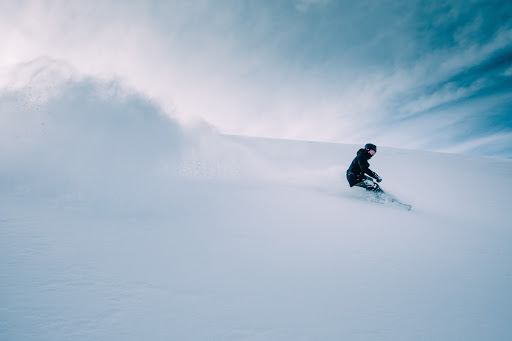
How to Prevent Winter Sports Injuries With Nine Simple Exercises
At the base of most ski resorts sits an idyllic lodge. Large wood beams, vaulted ceilings. Skis lined up in nice rows outside the front door. Beautiful views of the slopes from sweeping windows. And, the enticing aroma of hot chocolate.
The ski lodge is the perfect place to slide off your ski boots and warm up after a beautiful morning on the slopes. It seems almost like a dream. You can feel the warmth returning to your toes while the marshmallows dissolve in your hot chocolate. Sounds wonderful, doesn’t it?
Wonderful that is until you wake-up from your dream and realize that an unfortunate accident on the slopes has sidelined you to the lodge for the entire season. After an injury, the idyllic lodge looks more like a crowded cafeteria. And the hot chocolate – it’s just not the same.
In both skiing and snowboarding, lower extremity injuries are the most common. This includes bone fractures, torn ligaments, joint injuries, and sprains or strains. 80% of these injuries occur while the skier is in motion – turning, jumping or landing. A third of those injuries are severe and lead to time away from the slopes. Head injuries follow a close second and are usually caused by an impact from a crash. Watch out for those trees!
OSPT Physical Therapist Dr. Kailey Edgar shares that focused physical conditioning can go a long way to improving your ski season. Hamstrings, core, and hip abductors are some of the most common muscles used during skiing and snowboarding. Strengthening these three areas can help prevent common, yet traumatic injuries like ACL tears.
Learn more about the nine strength and flexibility exercises Dr. Edgar recommends to help prevent winter sports injuries. And, read some of her tips and tricks to make these exercises work for you.
Lateral Monster Walks
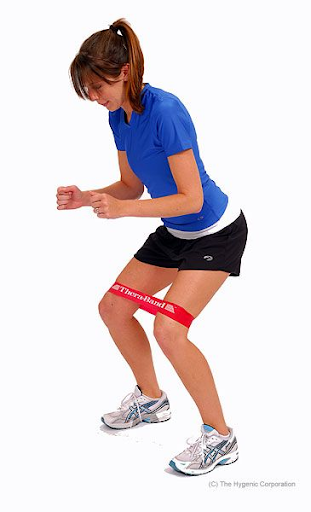
Lateral monster walk works all the major muscles in your hips, thighs, and legs. In addition, this exercise can help improve flexibility and stability critical for preventing snow sport injuries.
- Start by placing a resistance band around both legs. Stand with your feet hip-width apart.
- Squat about halfway down.
- Take a moderate step out sideways to the right.
- Return your left leg to the starting position resisting the pull of the exercise band.
- Complete 3 sets of 20 reps on each side.
Dr. Edgar’s Tip: Try to stay low into your squat and avoid dragging your feet as you move side to side.
Single-Leg Lateral Hops
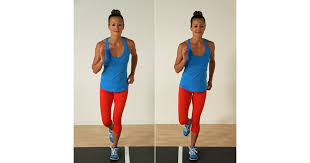
Hopping side-to-side is a good way to strengthen the lower body and build ankle stability. This exercise is especially beneficial when making quick lateral direction changes like those in skiing.
- Balance on your left foot with your right slightly off the ground.
- Hop side-to-side over an imaginary line for 30 reps.
- Switch feet to balance on the right and repeat.
- Complete 3 sets of 30 reps on each side.
Dr. Edgar’s Tip: Imagine you’re skiing down a hill – find a line and try to get as many hops as you can in 30 seconds.
Double Leg Hops
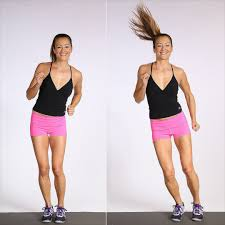
Like single-leg lateral hops, this exercise can improve strength, coordination, and stability. The double leg hop focuses on developing the glutes, hamstrings, calves, and quads. Strengthening these muscles gives the body the ability to make a forceful, quick turn while protecting it from injury.
- Stand with your feet hip-width apart. Squat about halfway down and keep your head up.
- Jump over an imaginary line right to left keeping the beginning position with each landing.
- Complete 3 sets of 30 total jumps
Dr. Edgar’s Tip: Are you finding these jumps too hard to do over a line? Try light hops or jumping rope instead.
Standing Hip Abduction
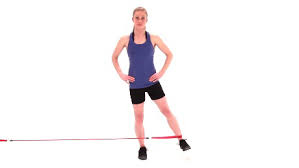
Standing hip abduction exercises help to develop muscles that support the body when moving side to side. These muscles are often weakened from large amounts of sitting. But, focused exercises can help to develop stability and protect the knee and hip from injury.
- Start by standing on the right leg with the left leg slightly raised to the side. Option to use an exercise band around your ankles.
- Slowly raise the left leg up a few inches and back down resisting the pull from the exercise band.
- Complete 3 sets of 12 on each side.
Dr. Edgar’s Tip: Keep your body upright to help feel a nice burn in your outer hip. A little too much? You can do this exercise lying on your side as well.
Single-Leg Deadlift
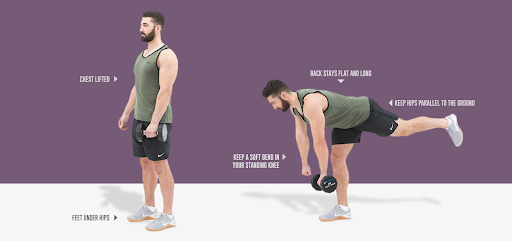
A single-leg deadlift involves hinging at the waist to build strength in the back, core, and legs. Balancing on one leg during this exercise gives an extra balance and stability challenge. Plus, the glutes will have some extra burn.
- Begin by standing with your feet hip-width apart and toes facing forward.
- Lean forward slightly shifting your weight onto one leg while the other leg begins to extend straight behind you.
- Keeping a slight bend in your standing leg, begin to hinge the upper body forward while the extended leg lifts to form a T shape with the body.
- Slowly lower the leg and return your upper body to the starting position.
- Repeat for 10 reps and then switch standing legs for 3 total sets.
Dr. Edgar’s Tip: If you are just getting started try completing this exercise without weights. Add hand weights or a kettlebell for an increased challenge. Remember to keep your knees softly bent and you back flat.
Side Lunge
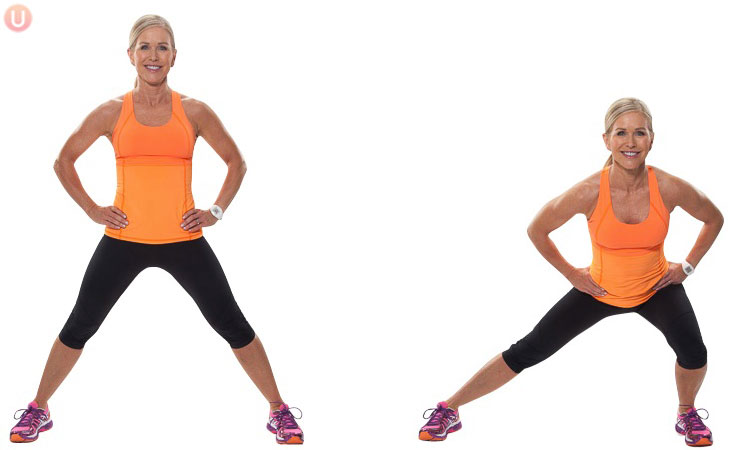
Increasing hip and glute strength and flexibility comes naturally with side lunges. If you experience tightness in your hips adding this exercise to your routine a few times per week can help.
- Begin by standing with your feet hip-width apart and toes facing forward.
- Step out wide with your right foot and drop the hip down and back. Keep the left leg straight.
- Push up from your right foot back to your starting position.
- Complete 8 to 12 reps on each side for 3 total sets.
Dr. Edgar’s Tip: Imagine you have a chair behind you and sit back into it. Ensure your knee stays over your foot as you squat low.
Curtsy Lunge
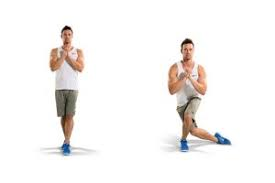
The curtsy lunge is a great exercise to stabilize your hips while building glute strength. This exercise is a slight variation on a standard lunge. But, curtsy lunges target glute muscles that may not be as activated in a standard lunge.
- Begin by standing with your feet hip-width apart.
- Step back with your right leg crossing it behind your left.
- Drop your knee into a lunge position hovering the knee just a few inches above the floor.
- Return to the original standing position.
- Complete 8 to 12 reps on each side for 3 total sets.
Dr. Edgar’s Tip: Just as if you were meeting the Queen! Don’t feel the burn? Make sure you drop down low enough. Still too easy? You can add a jump before each squat.
Swiss Ball Hamstring Curl
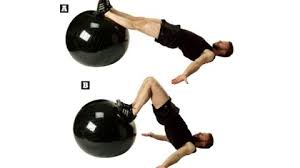
The swiss ball hamstring curl is a hamstring killer. This exercise also works the core, glutes, and lower back for a great calisthenic exercise. This exercise requires a large exercise ball.
- Begin by lying flat on your back on the floor. Arms straight out from the shoulders on the floor for extra stability.
- Place heels on the swiss ball with legs out straight. Raise hips up to form a line between your knees and hips.
- Roll the ball in toward your glute until your feet are flat on the ball and your knees face the ceiling.
- Keeping your hips raised, extend your legs back straight until your heels are on the ball.
- Complete 4 sets of 8 reps.
Dr. Edgar’s Tip: Remember breathing is important. Exhale as you bring the ball in and inhale on the way out. Keep your core in tight to help support your lower back. These should burn your legs but not hurt your back!
Standing Hip Extension
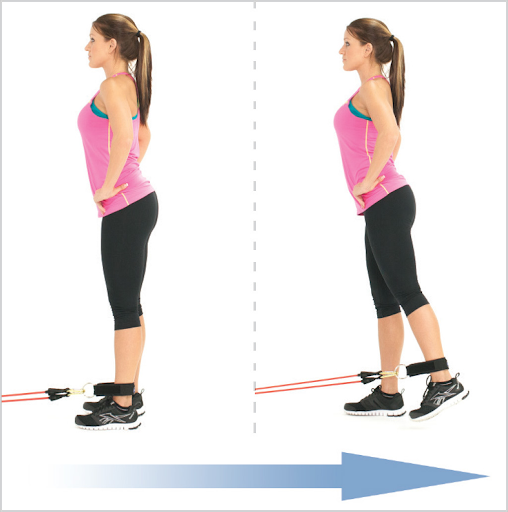
The standing hip extension helps to open and lengthen the front of the hip. Hip extensors – the glutes and hamstrings – help the body in large movements. Such as, standing from a seated position, walking, and running. Standing hip extension helps to promote strong glutes and hamstrings for pelvic and low back stability.
- Begin by standing at a counter or chair for support.
- Raise the right leg behind you 3 to 4 inches keeping the leg straight.
- Slowly lower the leg to the starting position.
- Complete 3 sets of 10 reps.
Dr. Edgar’s Tip: Before raising your leg, tuck your tail under (posterior pelvic tilt) to ensure there is no movement in your lower spine. Then squeeze those glutes!
Don’t miss out on a ski season, the hot chocolate, or the idyllic lodge. By incorporating simple exercises into both your pre-season and in-season workouts, you can help prevent common skiing related injuries.
The popularity of snow sports is growing in America with skiing and snowboarding at the top of the list. It’s not hard to believe that these sports are popular here in Montana. With our long winters and large snowfalls, we have some of the best powder and groomed runs around.
Physical conditioning for your time on the slopes is important. The better physical condition you are in, the less likely you’ll sustain a traumatic injury.
Take your ski season to the next level with support from one of the Physical Therapists at Optimal Sports Physical Therapy. Call our office today to schedule a visit at (406) 502-1782 or check out our website to learn more.
